|
|
ARTHROPODS:
Insects»
Spiders»
Centipedes»
Millipedes»
Sowbugs»
Harvestmen»
Mites
& Ticks»
Scorpions»
Identification
Tips»
About
the Critter Files»
Links» |
|
|
|
 |
NARROW-WAISTED
SOLITARY WASPS
Critter
Files/Insects/Wasps,
Ants, & Bees/Solitary Wasps
By Katja Seltmann and Blake Newton
University of Kentucky Department of Entomology |
| |
|
| Common
Kentucky Solitary Wasps: |
| |
| TAXONOMY |
KINGDOM:
Animalia | PHYLUM: Arthropoda | CLASS: Insecta | ORDER : Hymenoptera
| SUBORDER: Aprocrita (narrow-waisted wasps, ants, and bees) |
| |
WHAT
ARE SOLITARY WASPS?
LIFE CYCLE
ECOLOGY
PEST STATUS
COMMON KENTUCKY SOLITARY WASPS
COLLECTING & PHOTOGRAPHY
SOLITARY WASP FACTS
MYTHS, LEGENDS, AND FOLKLORE |
| |
| WHAT
ARE SOLITARY WASPS? |
|
This page
is devoted to a large group of narrow-waisted wasps from several
different families collectively known as "Solitary
Wasps." This group includes all narrow-waisted
wasps that do NOT live in hives or colonies. Most of these
wasps are parasitic: parasitic wasps are solitary wasps whose
offspring feed on or inside other arthropods.
There are hundreds of
species of narrow-waisted solitary wasps that live in Kentucky.
Most of them are ant-like in appearance, with narrow waists
and thread-like antennae. All solitary wasps have 4 membranous
wings except for a few types, such as velvet ants, which do not
have any wings. The best way to distinguish a solitary wasp
from a social, hive-dwelling
wasp is to observe behavior: hive wasps will stay close to their
hive and return to it often during their routine; solitary wasps
may have a small burrow or nest that they return to, but it will
be much smaller than the hive of a social wasp. In addition,
you will rarely see solitary wasps interacting with other wasps,
while hive-dwelling wasps will often communicate with one another,
often by touching antennae or legs. |
| |
|
| SIZE:
Adult body length varies with species. The smallest parasitic wasps
are less than 1/8th" long, the largest solitary wasps are about
2" long. |
| |
| LIFE
CYCLE |
|
Like
all wasps, solitary wasps have complete metamorphosis with egg,
larva, pupa, and adult stages. Many large narrow-waisted solitary
wasps (such as mud-daubers, cicada killers, and potter wasps) build
small nests or burrows in which they lay eggs. Within this
burrow, the wasp encloses an insect or spider that has been stung
and paralyzed. When the wasp eggs hatch, the tiny wasp larvae
feed on the paralyzed prey items, and receive no further care from
the mother. Small internally-parasitic wasps, such as ichneumon
and braconid wasps, do not build nests or burrows. Instead,
they hunt for insects, insect larvae, or insect eggs and lay their
own eggs inside. When the larvae hatch, they feed and grow
inside the host. Most solitary wasps are active in summer
and fall and overwinter as eggs or pupae.
|
| |
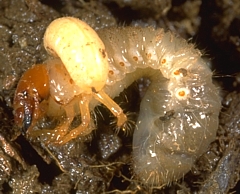 Shown
above is a beetle grub being fed upon by the larva
Shown
above is a beetle grub being fed upon by the larva
of a tiphiid wasp. The tiphiid larvae is the smaller insect
in the picture. (R. Bessin, 2000) |
| |
| ECOLOGY |
|
Although they are not
as well-known as paper wasps, hornets, and yellow-jackets, there
are many species of narrow-waisted solitary wasps in Kentucky, including
hundreds of parasitic wasps.
Solitary wasps and parasitic
wasps are an important component in a variety of ecosystems: almost
all solitary wasp species provide insects or spiders to their larvae,
either by laying their eggs in burrows provisioned with prey or
by laying their eggs inside insect hosts. Most species are
very specific about the types of prey that they hunt. Mud-daubers,
for instance, pack their mud tubes with spiders. Wasp species
that are internal parasites will usually lay their eggs in only
one or two insect species and are specific about which stage in
the life-cycle that they attack: some species attack only larvae,
some attack only eggs, some attack only adult insects or pupae.
Most adult solitary wasps feed on nectar. Solitary wasps
are found in most Kentucky habitats, from farms and lawns to forests
and stream sides.
Although most solitary
wasps have stingers, the stingers are not used for defense as often
as with hive wasps. A few species, like cicada killers and
mub-daubers, are able to sting in defense. Many parasitic
wasps species have stingers that are only used to place eggs inside
hosts and cannot be used in defense. Because of this, many
solitary wasps are fed upon by birds, spiders, and other wasps.
|
| |
| PEST
STATUS |
|
Because
their larvae feed on other insects, most species of narrow-waisted
solitary wasps are considered beneficial. A few types, such
as cicada killers, are large enough and common enough in urban areas
that they are sometimes considered pests, even though they rarely
sting people. Read our ENTFact about pest Cicada
killer wasps for more information. |
| |
| COMMON
KENTUCKY SOLITARY WASPS |
|
|
SPHECID
WASPS
FAMILY: Sphecidae
There are many species
of Sphecid Wasps in Kentucky. Most are shiny
black or metallic blue, some with bright red, yellow, or orange
markings. The most common sphecid wasps are in the subfamily
Sphecinae and are called "Thread-Waisted Wasps."
These sphecids have a long, narrow, antlike appearance. Most
thread-waisted wasps build their nests underground. Some sphecids,
often called "mud-daubers," make mud nests for their larvae
which they attach to the sides of rocks and buildings. The
Cicada Killer Wasp (Sphecius specious)
is also a type of Sphecid wasp. At 1 1/2," cicada killers
are the largest wasps found in Kentucky. They are commonly
seen in late summer as they hunt for cicadas which they use to provision
their eggs in underground burrows. Like many sphecid wasps,
cicada killers are able to sting people, but they will not do so
unless provoked. |
| |
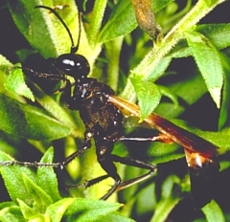 Thread-Waisted
Wasp (R. Bessin, 2000)
Thread-Waisted
Wasp (R. Bessin, 2000) |
 Cicada
Killer Wasp (R. Bessin, 2004)
Cicada
Killer Wasp (R. Bessin, 2004) |
| |
|
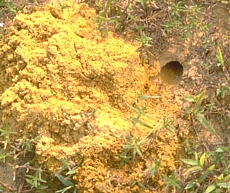 Cicada
Killer Burrow (R. Bessin, 2000)
Cicada
Killer Burrow (R. Bessin, 2000) |
|
|
|
SPIDER
WASPS
FAMILY:
Pompilidae |
|
These
large wasps are called Spider Wasps because their
young feed on paralyzed spiders. They generally are black
or brown but some are brightly colored or metallic. Spider
wasps are common and are often observed searching for spiders on
lawns. Others can be seen moving quickly along the trunks
of fallen trees, flitting their wings. Like other stinging
wasps (including Hive Wasps,
Bees, and Cuckoo
Wasps), female spider wasps have their egg laying device modified
into an effective (and sometimes painful) stinger. Common
Kentucky spider wasps are about 1" long. |
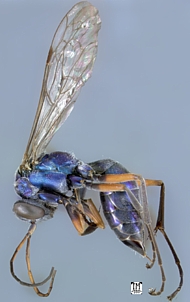 Spider
Wasp (K. Seltmann, 2004)
Spider
Wasp (K. Seltmann, 2004) |
|
|
|
POTTER
WASPS
FAMILY:
Vespidae | SUBFAMILY: Euparagiinae
Solitary
Potter Wasps are in the same family (Vespidae) as the social,
hive-dwelling hornets and yellowjackets. Potter wasps are named
because some species construct small (1" inch) balls of mud in
which they lay their eggs. Potter wasps place caterpillars in
these mud nests for their larvae to eat. Common potter
wasps are black with yellow or white markings are are 1/2-3/4"
long. |
| |
 Potter
Wasp (R. Bessin, 2002)
Potter
Wasp (R. Bessin, 2002) |
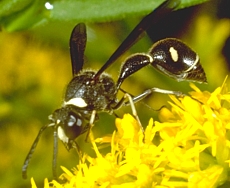 Potter
Wasp (R. Bessin, 2002)
Potter
Wasp (R. Bessin, 2002) |
|
|
|
VELVET
ANTS
FAMILY: Mutillidae
Velvet Ants
are large (1" long) wasps in the family Mutillidae. Although
they are wasps, they are called ants because the females do not
have wings. Male velvet wasps usually have shiny black wings.
Velvet ants are covered in dense hair, and most species are
bright red or orange with black markings, although some species
are metallic green. Common velvet ant females place their
eggs in the larval and pupal chambers of bee and wasp nests. Large
velvet ants have very long stingers and are sometimes called "cow
killers," but they will only sting if grabbed or if stepped
on with bare feet. |
| |
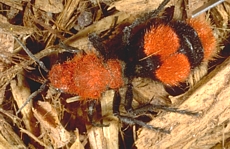 Velvet
Ant (R. Bessin, 2000)
Velvet
Ant (R. Bessin, 2000) |
|
|
|
SCOLIID
WASPS
FAMILY: Scoliidae
| GENUS: Scolia
Often
seen on Kentucky lawns in summer, the most common Scoliid
Wasps are black with orange and yellow markings and are
about 3/4" long. These wasps are sometimes called "digger
wasps" because a female scoliid will dig into soil for a beetle
larva. She will then paralyze the larva with a sting and lay
one egg on the larva. She then constructs a small underground
chamber for the egg and the beetle larva. When the larva hatches,
it will feed on the beetle larva. |
| |
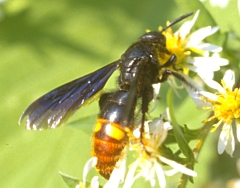 Scoliid
Wasp (R. Bessin, 2002)
Scoliid
Wasp (R. Bessin, 2002) |
|
|
|
TIPHIID
WASPS
FAMILY: Tiphiidae
Tiphiids
are shiny black wasps that are similar in size (1 3/4" long),
shape, and behavior to scoliid wasps. Like
scoliids, tiphiid wasp females hunt in soil for beetle grubs on
which they place single eggs. Because they kill turf-damaging
beetle grubs, some tiphiid wasps species are considered beneficial.
You can see a picture of a tiphiid larva feeding on a beetle
grub in the Life Cycle section above. |
| |
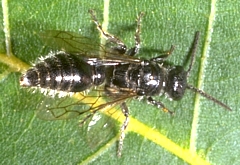 Tiphiid
Wasp (R. Bessin, 2002)
Tiphiid
Wasp (R. Bessin, 2002) |
|
|
|
ICHNUEMON
& BRACONID WASPS
FAMILY: Ichnuemonidae
(ichnuemon wasps) & Braconidae (braconid wasps)
Parasitic wasps in the
closely-related families Ichnuemonidae and Braconidae, known as
Ichnuemon and Braconid Wasps,
are some of the most economically beneficial insects in Kentucky.
The many species of ichnuemon and braconid wasps that live
in Kentucky attack a variety of insects, including many pest species.
Ichnuemon and braconid wasps are generally antlike in appearance,
usually with dark colors and sometimes with orange or yellow markings.
They are difficult to tell apart: ichnuemon wasps (1/8"
- 1 1/2") are usually larger than braconids (1/8" - 3/4"),
but there is much size overlap. Many ichnuemon wasps have
long "ovipositors" on the ends of their abdomens. An
ovipositor is used to deposit eggs. Many female insects have
ovipositors, but they are sometimes especially long in parasitic
wasps, who use them to probe underground and inside plant material
for insect hosts. |
| |
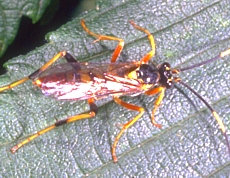 Ichnuemon
Wasp (R. Bessin, 2002)
Ichnuemon
Wasp (R. Bessin, 2002) |
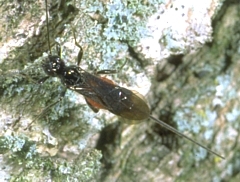 Braconid
Wasp (R. Bessin, 2002)
Braconid
Wasp (R. Bessin, 2002) |
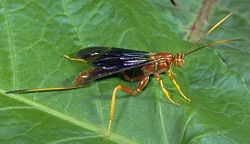 Ichnuemon
Wasp (R. Bessin, 2000)
Ichnuemon
Wasp (R. Bessin, 2000) |
| |
| Although most
Hymenoptera have wings, there are a few exceptions. The 2mm ichnuemon
wasp pictured below is completely wingless. Winglessness occurs
in at least one species of most of the hymenopteran families, showing
biologists that it is fairly common for a group of insects to evolve
from winged to wingless over time. |
| |
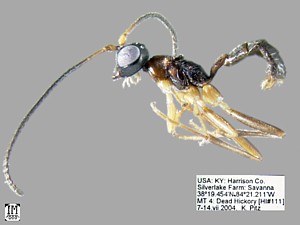 Wingless
Ichnuemon Wasp (K. Seltmann, 2004)
Wingless
Ichnuemon Wasp (K. Seltmann, 2004) |
|
|
|
CHALCIDID
WASPS
FAMILY: Chalcididae
These small (less than
1/4") parasitic wasps are found worldwide. The Chalcidiae
family consists of almost 2000 described species, and all have the
enlarged, clasping hind legs. These legs are used for fighting
among females and clasping onto struggling hosts when a female attempts
to lay an egg. One species of Chalcididae uses these clasping
hind legs to hold the jaws of an antlion (Neuroptera) while she
lays an egg down the antlion’s throat! |
| |
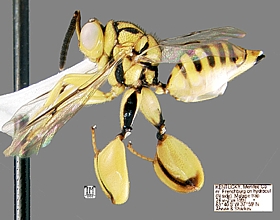 Chalcidid
Wasp (K. Seltmann, 2004)
Chalcidid
Wasp (K. Seltmann, 2004) |
|
|
|
CUCKOO
WASPS
FAMILY: Chrysidiae
Commonly called Cuckoo
Wasps, the wasps in the family Chrysidiae are often beautiful
and metallic blue, green or red. Some species are thieving parasites
(cleptoparasites) who lay their eggs in the nests of solitary bee
species. The Cuckoo wasp larva kills the solitary bee larva
and then feeds on the stored provisions within the bee nest. Like
hive wasps, spider
wasps, sphecid wasps, and bees,
female cuckoo wasps have modified egg-laying devices which allow
them to sting. Common cuckoo wasp species are about 1/2"
long. |
| |
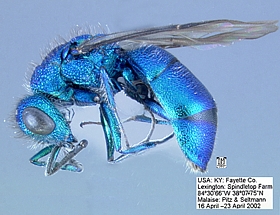 Cuckoo
Wasp (K. Seltmann, 2004)
Cuckoo
Wasp (K. Seltmann, 2004) |
|
|
|
MEGASPILID
WASPS
FAMILY: Megaspilidae
Very little is known about
the habits of these tiny wasps, perhaps because they are at most
3mm long. They occur worldwide and are thought to be parasites
of scale insects (Coccoidea), lacewings
(Neuroptera) and many fly
pupae (Diptera). The female Megaspilidae lays an egg inside
a host insect and the larva develops feeding inside usually killing
the host insect. |
| |
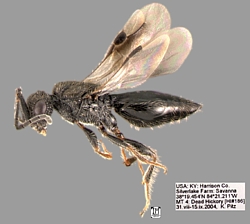 Megaspilid
Wasp (K. Seltmann, 2004)
Megaspilid
Wasp (K. Seltmann, 2004) |
|
|
|
PELECINID
WASPS
FAMILY: Pelecinidae
| GENUS and SPECIES: Pelecinus polyturator
With their long, thin
abdomens and shiny black bodies, Pelecinid Wasps
are among the most distinctive insects found in Kentucky. These
large (1 3/4" long) parasitic wasps lay their eggs inside beetle
grubs. |
| |
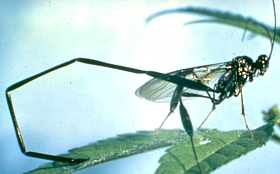 Pelecinid
Wasp (USDA)
Pelecinid
Wasp (USDA) |
|
| |
| COLLECTING
& PHOTOGRAPHY |
|
During warm months,
solitary wasps are commonly found in lawns, gardens, field crops,
woodlands, and weedy fence rows. Most species fly slowly as
they search for prey or visit flowers for nectar. Although
solitary wasps are less likely to sting than hive-dwelling wasps,
some (like sphecid wasps) will sting when captured, so it is best
to capture them with an insect net and immediately place them in
a sturdy container. Although solitary wasps usually fly slowly,
they are almost always on the move, so it can be difficult to get
a good picture. The best technique is to keep your camera
focused on a flower that is being visited by lots of insects - within
a few minutes, a wasp will probably visit, and you can snap a picture.
|
| |
| SOLITARY
WASP FACTS |
|
|
To learn more about
the science of Hymenoptera taxonomy, visit the Hymenoptera
- Assembling the Tree of Life web project. This project
is devoted to developing a family tree and taxonomic keys for all
Hymenoptera and is part of the initiative to create an inclusive
Tree of Life for all organisms. Contributors to this project
include Katja Seltmann, Kevin Pitz, Barb Sharanowski, Carlos Sarmiento-Monroy,
and Mike Sharkey of the University of Kentucky Department of Entomology.
Parasitic wasps like
ichnuemons and braconids are very important in agriculture because
they can reduce pests numbers. This website from Cornell University
has profiles of some of the most important wasps used to control
pests:
http://www.nysaes.cornell.edu/ent/biocontrol/parasitoids/parastoc.html |
| |
| MYTHS
- LEGENDS - FOLKLORE |
|
| Velvet
ants are sometimes called "cow killers" because it is
believed that a sting from one is powerful enough to kill a cow. Although
velvet ant stings are painful, they are not powerful enough to
kill a cow! |
|
Original document: 25 May 2004
Last updated: 2 July 2007
Pelecinid Wasp photo
courtesy USDA. Other photos courtesy R. Bessin, K. Seltmann, and
B. Newton, University of Kentucky
The Kentucky Critter Files are maintained by Blake Newton, Department
of Entomology, University of Kentucky.
Contact: blaken@uky.edu |
|

